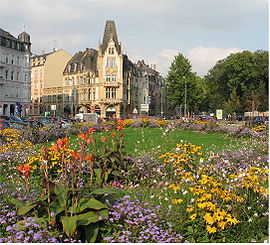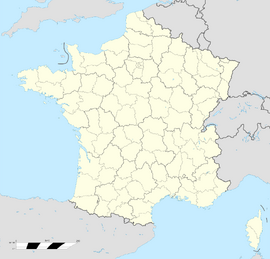| Main | Births etc |
|---|
| Thionville | |||
|---|---|---|---|
|
|||
| Coordinates: Coordinates: | |||
| Country | France | ||
| Region | Grand Est | ||
| Department | Moselle | ||
| Arrondissement | Thionville Est and Ouest | ||
| Intercommunality | Portes de France-Thionville | ||
| Government | |||
| • Mayor (2008–2014) | Bertrand Mertz | ||
| Area1 | 49.86 km2 (19.25 sq mi) | ||
| Population (1999)2 | 40,907 | ||
| • Density | 820/km2 (2,100/sq mi) | ||
| INSEE/Postal code | 57672 / 57100 | ||
| Elevation | 147–423 m (482–1,388 ft) (avg. 150 m or 490 ft) |
||
| 1 French Land Register data, which excludes lakes, ponds, glaciers > 1 km² (0.386 sq mi or 247 acres) and river estuaries. 2 Population without double counting: residents of multiple communes (e.g., students and military personnel) only counted once. | |||
Thionville (French pronunciation: [tjɔ̃vil]; Luxembourgish: Diddenuewen; German: Diedenhofen (help·info)) is a commune in the Moselle department in Lorraine in north-eastern France. The city is located on the left bank of the river Moselle, opposite its suburb Yutz.
Demographics[]
The population of Thionville boomed in the Industrial Revolution, but the economic slowdown of the 1970s affected the town and the surrounding area, causing a population decrease. The population rose again in the 1990s and in suburban Hettange-Grande in the east, although the population of the western part of the new agglomeration is decreasing around Hayange. The agglomeration is still losing population but the decrease has been slowed down.
Due to Thionville's proximity to Luxembourg (15 kilometres from the border), the town's population and quality of life have both increased since the end of the 1990s.
History[]

The 16th- and 17th-century bell tower of the old city hall.
Thionville was settled as early as the time of the Merovingians. After the fall of the Western Roman Empire, the region was inhabited by the Germanic Alamanni. It was known in the German of that era as Theudonevilla or Totonisvilla. King Pippin had a royal palace constructed here.
The Synod of Thionville was held here beginning on February 2, 835. It reinstated Emperor Louis the Pious and reversed his former conviction on crimes — none of which he actually committed — and deposed the Archbishop of Rheims, Ebbo. The Synod was composed of 43 bishops. On February 28, 835, in Mainz, Ebbo admitted that Louis had not committed the crimes of which he had been indicted and for which he had been deposed as Holy Roman Emperor.
From the 10th century onward, the area was part of the Holy Roman Empire. It was in possession of the House of Luxembourg until 1462 and then, until 1477, of the Duke of Burgundy. From 1477 to 1643 it was Hapsburg territory.
Eskil, Archbishop of Lund, was imprisoned at Thionville (at the instigation of the Archbishop of Bremen?) upon his return from his 1153 pilgrimage to Rome.
The Siege of Thionville in June 1639 occurred as part of the Thirty Years' War. In 1659 Diedenhofen was annexed by France. Fortifications were constructed under the direction of Sébastien de Vauban.
In 1792, Thionville was besieged by the Duke of Brunswick, who unsuccessfully sought to defeat the French Revolution and restore Louis XVI to the royal throne. The writer François-René de Chateaubriand was left for dead during Condé's military émigré expedition against Thionville in 1792.
After the Franco-Prussian War of 1870, the area of Alsace-Lorraine was annexed by the newly created German Empire in 1871 by the Treaty of Frankfurt and became a Reichsland. Thionville was renamed Diedenhofen and became a prosperous German city. Some large neo-Romanesque buildings typical of the German Empire were constructed in the city. The German Army decided to build a fortress line from Mulhouse to Luxembourg to protect the new Reichsland. The centerpiece of this line was the great Moselstellung, a fortress system protecting Metz and Thionville.
The fortifications around Thionville centered on three main forts: the Fort de Guentrange on the northwest side of Thionville, Fort de Koenigsmacker to the northeast, and the Fort d'Illange to the south. Each position was surrounded by several ditches, with shelters and observation cupolas. A large barbed wire belt defended by machine guns completed the defensive system.
Following the armistice with Germany ending the First World War, the French army entered Thionville in November 1918 and the city was returned to France by the Treaty of Versailles in 1919.
During the Second World War, the Lorraine was placed under a German civilian administration and was thus once again unofficially part of the German Reich. In 1944 US troops entered Thionville, which has belonged to France since then. In the winter of 1944-45 the Displaced Persons Camp No. 8 was established here. In the following years it was home to the thousands of former concentration camp prisoners and POWs.
After experiencing, along with all of France, an economic upswing during the postwar decades (trente glorieuses), the heavy industry of Thionville suffered setbacks beginning in the 1970s. The city and the entire region have faced hardships and structural unemployment since then.
Jean-Marie Demange, who had served as the town's mayor for thirteen years, committed suicide in 2008 after killing his mistress with two gunshots in the head.
Economy[]
The following industries are present in or near Thionville:
- An iron and steel plant
- A chemical plant
- A cement factory
Transport[]
The Gare de Thionville railway station offers connections with Luxembourg, Metz, Nancy, Paris, Strasbourg, Brussels, Zürich, and several regional destinations. The A31 motorway connects Thionville with Luxembourg and Metz.
Twin towns[]
- Gao, Mali
Administration[]
Incorporations:
- Veymerange, in 1967
- Volkrange, in 1970
- Garche (not contiguous with the rest of the commune), Kœking and Œutrange in 1970
- Guentrange
- Elange
- Metzange
- Beuvange-sous-Saint-Michel
Thionville is divided into two cantons: Thionville Est, which includes the city, and Thionville Ouest.
- Thionville Est: 19,063 (46.6% of the total population)
- Thionville Ouest: 21,844 (53.4% of the total population)
Notable people[]
- Johann von Aldringen (1588-1634)
- Joseph Bodin de Boismortier (1689 - 1755)
- Antoine Merlin de Thionville (1762-†1833)
- Nicolas Dahlmann (1769-1807)
- Isidore Didion (1798-1878)
- Aimé de Lemud (1816-1887)
- Senta Söneland (1882-1934)
- Wendelin Thomas (1884- 1947)
- Helmuth Volkmann (1889-1940)
- Fritz von der Lancken (1890-1944)
- Franz Vaterrodt (1890-1969)
- Joseph Schneider (1900-1986)
- Gerhard Borrmann (1908-2006)
- Ernest Bour (1913-2001)
- Henry Anglade (1933-)
- Francis Renaud (1967-)
- Rachid Arhab (1955-)
- Julien Quercia (1986-)
- Carole Gaessler (1968-)
- La Grande Sophie (1969-)
- Eddy Riva (1973-)
- Nasredine Kraouche (1979-)
- Benjamin Corgnet (1987-)
See also[]
- Merlin of Thionville
Sources and external links[]
| Wikisource has the text of the 1911 Encyclopædia Britannica article Diedenhofen. |
- Thionville Official website
- Taxis de Thionville
- Page Thionville
- Nombreuses photos de Thionville de 1900 a nos jours
- Site alternatif portail de Thionville
- Not official Thionville Web site
This article incorporates text from a publication now in the public domain: Herbermann, Charles, ed (1913). Catholic Encyclopedia. Robert Appleton Company. passim
| |||||
| This page uses content from the English language Wikipedia. The original content was at Thionville. The list of authors can be seen in the page history. As with this Familypedia wiki, the content of Wikipedia is available under the Creative Commons License. |




